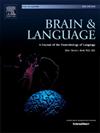Neural substrates for the encoding of the contextual tonal alternation: An fNIRS study of Mandarin third-tone sandhi in word production
IF 2.3
2区 心理学
Q1 AUDIOLOGY & SPEECH-LANGUAGE PATHOLOGY
引用次数: 0
Abstract
Phonological alternations are common in speech, but the neurocognitive mechanisms for their encoding during word production remain unclear. Mandarin Tone 3 sandhi is an example of phonological alternation, whereby the Tone 3 (T3), a low-dipping tone, changes to a Tone 2 (T2)-like rising tone when followed by another T3. Previous research indicates that both the underlying tonal category and the surface tonal variant are activated during T3 sandhi word production, but the neural substrates of these sub-processes remain unclear. Using Mandarin T3 sandhi as a case study, we employed functional near-infrared spectroscopy (fNIRS) to better understand the neural bases of phonological alternations. Participants completed a phonologically-primed picture naming task, with different tonal relationships between monosyllabic primes and T3 sandhi words manipulated. Behaviorally, we replicated the facilitatory effects of T3 and T2 primes on the naming latencies of T3 sandhi words, confirming the activation of both underlying and surface tonal information. Compared to control primes, the fNIRS data revealed reduced activation in left temporal and bilateral frontal regions during T3 sandhi word production following T3 primes, indicating facilitation in retrieving the underlying tonal category and/or the wordform of T3 sandhi words, which may proceed to the downstream articulatory planning and execution of the context-specific tonal contour. Conversely, increased activation in left temporal regions but decreased activation in frontal regions was found during T3 sandhi word production following T2 primes, implying higher lexical-phonological competition in the wordform retrieval but facilitation in articulatory planning. Our findings offer implications for understanding the neural encoding of phonological alternations.
语境变调编码的神经基础:汉语三音变调的fNIRS研究
语音变化在言语中很常见,但在单词生成过程中其编码的神经认知机制尚不清楚。普通话调三连读是音位变化的一个例子,即调三(T3),一个低下沉的音调,在另一个调三之后变成一个类似调二(T2)的上升音调。先前的研究表明,在T3变调词生成过程中,潜在的音调类别和表面的音调变体都被激活,但这些子过程的神经基础尚不清楚。本文以普通话T3变调为例,利用功能近红外光谱(fNIRS)分析了语音变化的神经基础。参与者完成了一项语音启动的图片命名任务,单音节启动和三个变调词之间存在不同的音调关系。在行为上,我们复制了T3和T2启动物对T3变调词命名潜伏期的促进作用,证实了底层和表面音调信息的激活。与对照启动词相比,fNIRS数据显示,在T3启动词产生过程中,左颞叶和双侧额叶区域的激活减少,表明在提取T3变调词的潜在音调类别和/或词形方面更容易,这可能会导致下游的发音规划和情境特定音调轮廓的执行。相反,在T2启动后的第三阶段,左颞区激活增加,额叶区激活减少,这意味着在单词检索中词汇-语音竞争加剧,但在发音规划中更容易。我们的发现为理解语音变化的神经编码提供了启示。
本文章由计算机程序翻译,如有差异,请以英文原文为准。
求助全文
约1分钟内获得全文
求助全文
来源期刊

Brain and Language
医学-神经科学
CiteScore
4.50
自引率
8.00%
发文量
82
审稿时长
20.5 weeks
期刊介绍:
An interdisciplinary journal, Brain and Language publishes articles that elucidate the complex relationships among language, brain, and behavior. The journal covers the large variety of modern techniques in cognitive neuroscience, including functional and structural brain imaging, electrophysiology, cellular and molecular neurobiology, genetics, lesion-based approaches, and computational modeling. All articles must relate to human language and be relevant to the understanding of its neurobiological and neurocognitive bases. Published articles in the journal are expected to have significant theoretical novelty and/or practical implications, and use perspectives and methods from psychology, linguistics, and neuroscience along with brain data and brain measures.
 求助内容:
求助内容: 应助结果提醒方式:
应助结果提醒方式:


